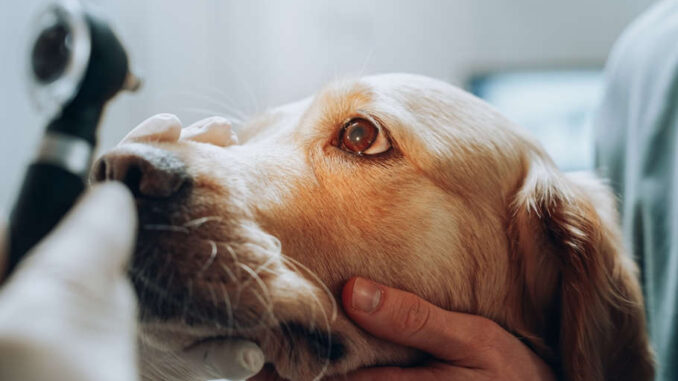
This article was updated on July 23rd, 2023
Golden Retrievers, like all dog breeds, are prone to certain health issues and eye-related ailments. As a skilled ophthalmologist, I have had plenty of experience dealing with these conditions in this breed. Let’s now review some of the eye issues in Golden Retrievers, starting with Pigmentary Uveitis.
Common eye issues in Golden Retrievers
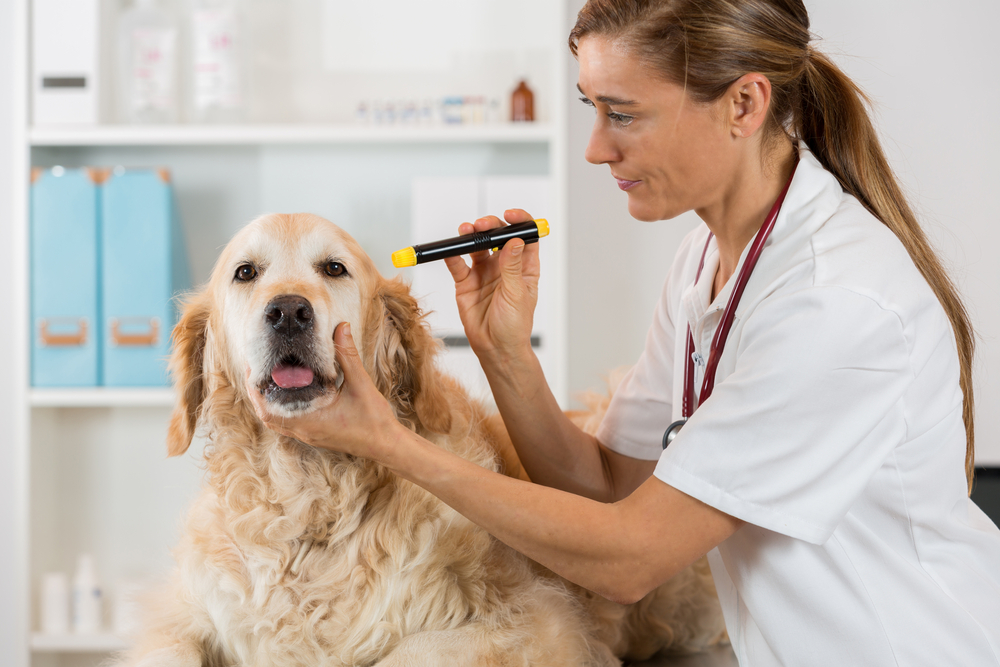
1. Pigmentary Uveitis
Pigmentary uveitis (PU) is a genetic condition that is prevalent in Golden Retrievers of 5-8 years or above. It can cause severe damage to the eyes and may necessitate surgery. It is also referred to as Golden Retriever Pigmentary Uveitis (GRPU).
This type of eye condition might start on just one side, but could eventually affect both eyes.[1]
Eye discoloration, such as the appearance of small dots or large spots in new places around the iris, may be an indicator that this disease is present and progressing. These are some signs to be aware of:
- The iris (the colorful part of the eye) appears dark and thickened.
- Pigment clumps (small dots of color) appear on the lens (in the dark space behind the pupil)
- Pigment cells and a foggy appearance are noticed inside the eye.
- Blood filled uveal cyst (a larger spot of discoloration in front of the iris)
- Spider web-like debris inside the eye.
- Posterior Synechaie (a condition where the iris becomes stuck to the lens)
Pigmentary Uveitis can even be the cause of additional complications such as[2]:
- Posterior Synechaie (see above)
- Post inflammatory cataract
- Glaucoma
Prevalence in Golden Retrievers:
As with most issues, estimates of prevalence may vary among studies and sample groups. This study estimated the prevalence of Golden Retriever Pigmentary Uveitis (GRPU) to be 23.9% for Golden Retrievers greater than 8 years of age. The mean age is about 8.5 years, but the age of onset can vary anywhere between 4.5 to 14.5 years of age.
Golden Retriever Pigmentary Uveitis causes secondary glaucoma and vision loss in 45%-46% of eyes.
Diagnosis:
The challenge of diagnosing GRPU isn’t just about identifying the condition but in deciding what collection of signs can be put together to officially diagnose.
Diagnosis of severely affected pigmentary uveitis is made through a comprehensive eye exam by a veterinary ophthalmologist.
The ophthalmologist will use special instruments to closely examine the eye and look for normal or abnormal structures, signs of inflammation, or other abnormalities.
Treatment: Treatment of GRPU remains challenging because the true underlying cause of the disease isn’t clear at this time. Treatment for pigmentary uveitis in Golden Retrievers may include medications (some applied to the eye, others given by mouth) to reduce inflammation and control the immune response, as well as supportive care to manage any complications that may arise.
Even with diagnosis, treatment, and management by a specialist, there is great potential for partial or total loss of vision with this disease.[3]
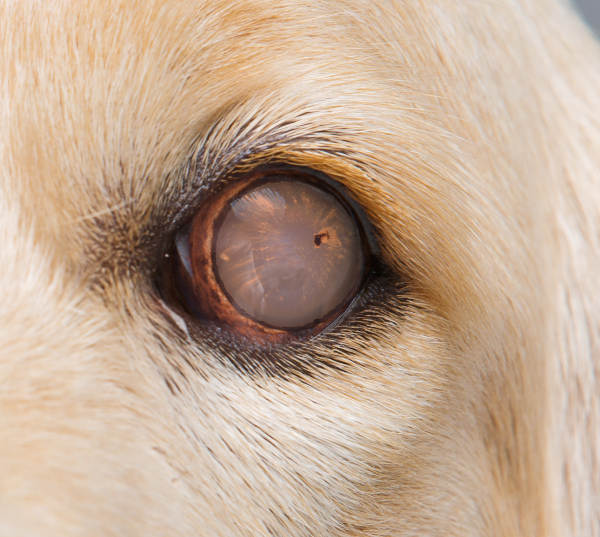
Pictured above is the eye of an 8-y-old, male, neutered Golden Retriever. Note the 12 clock hours of radial pigmentation and clump of pigment at the 2 o’clock position. Even though the iris is not darkly pigmented, this dog should be diagnosed as affected with pigmentary uveitis.
2. Cataracts
As a veterinarian ophthalmologist, I often assess and diagnose cataracts in Golden Retrievers. A cataract is an opaque cloudiness that forms in the lens of the eye. Cataracts may involve the lens completely (diffuse) or in a localized region. In cases where cataracts are complete and affect both eyes, blindness results.
Many cataracts are hereditary, though it’s possible to see cataracts happen secondary to[4]:
- Trauma.
- Other causes of ocular inflammation.
- Specific metabolic diseases (such as diabetes)
- Persistent pupillary membranes (a type of abnormal eye development that occurs even before birth)
- Persistent hyaloid. (another type of eye abnormality a dog can be born with)
- Nutritional deficiencies.
The most common cataracts reported in the Golden Retriever:
1. A posterior polar (posterior cortical) cataract is a common condition affecting Golden Retriever aged between 9 months and 3 years. This type of cataract has a genetic component, and while it usually affects both eyes, it’s also possible for it to affect just one eye. The cataracts can remain unchanged or may grow over time.
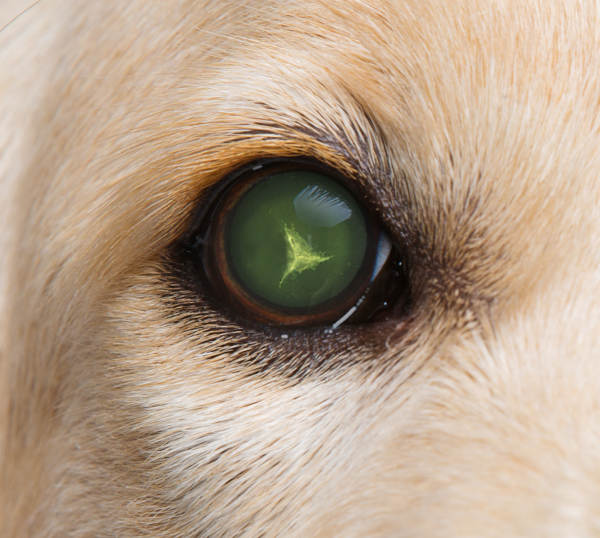
2. There are more generalized cataracts observed in this breed and are not always associated with the previously mentioned polar cataract.
3. There are also cataract changes involving the Y sutures which may or may not progress.[5]
Prognosis:
Golden Retrievers often have cataracts but these don’t usually cause any major problems. This can be a challenge for breeders as the majority of these dogs don’t show any signs of visual issues. [6]
Prevalence in Golden Retrievers:
The Journal of Small Animal Practice reported in 2008 that cataracts were seen in 21% of dogs, similar to some previous surveys (14.7% to 31.4%) (Donzel et al., 2016; Guandalini et al., 2017), although more than three times higher than other investigations looking at specific breeds.
Diagnosis & treatment:
It is strongly recommended that all Golden Retrievers that are used in breeding programs be examined annually as cataract changes have been observed in multiple locations of the lens and at variable age of onset.[7]
A Golden Retriever with a mature cataract and vision impairment can be recommended for surgery, to remove the cataract and restore its vision capabilities.
3. Progressive Retinal Atrophy (PRA)
A degenerative disease of the retinal visual cells which progresses to blindness, this means it’s a condition that gets worse over time, and affects the retina, which is the portion of the eye that does the actual ‘seeing’. This abnormality, is also known as progressive retinal atrophy or PRA.
PRA is a late-onset, inherited condition that is caused by recessive genes received from both parents. It appears that in this breed retinal atrophy is caused by more than one genetic mutation.
(Ocular Disorder; Presumed to be inherited in purebred dogs; 6th Edition; 2013; Genetics Committee of the American College of Veterinary Ophthalmologist; P 410)
Clinical signs:
- Progressive loss of vision.
- Tapetal hyperreflectivity (meaning when the veterinarian examines the eye, the back of the inside of the eye is more reflective than it should be)
- Pupils are more dilated.
- Cataract.
Diagnosis:
A dog can be diagnosed with PRA with the help of a thorough medical history, a comprehensive ophthalmic (eye) exam, and potentially an additional test called ERG (electroretinogram) which actually detects the natural electrical activity in the retinal portion of the eye.
Treatment:
Sadly, at present at least, there is no effective treatment for PRA and affected animals are likely to become totally blind. Antioxidant therapy has been suggested to attempt to delay vision loss in affected animals but there is no evidence to suggest this to be effective. Current research into gene therapy may provide some hope for the future but treatment is a long way off at this stage.
Other eye issues commonly affecting Golden Retrievers
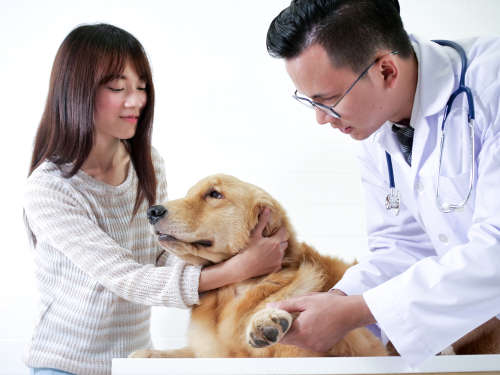
Entropion
A physical defect of the eyelid, which causes one or both (upper/ lower) eyelids to roll inward, toward the eye. This causes direct irritation to the eye and can be painful, even leading to other eye diseases like corneal scarring.
Entropion is likely influenced by several genetic factors, including excessive skin (rolls and wrinkles) around the face and eyes, thickened skin around the head and face, the depth and shape of the eye socket, and the shape of the skull.[8]
Distichiasis
Eyelashes abnormally located on the eyelid margin which may cause ocular irritation. Distichiasis may occur at any time in the life of a dog.
It is prominent in some breeds, so it can’t be ruled out as a hereditary condition, although no formal link exists at this time and it can affect a wide range of breeds.[9]
Corneal dystrophy – epithelial/stromal:
A non-inflammatory corneal opacity (white to gray discoloration or ‘spot’) present in one or more of the corneal layers – this is the surface of the eye; usually inherited and affects both eyes. (Ocular Disorder; Presumed to be inherited in purebred dogs; 6th Edition; 2013; Genetics Committee of the American College of Veterinary Ophthalmologist; P 410)
Uveal cysts:
Fluid filled sacs that come from the back surface of the iris. The sac might stay attached, or it may break free and float inside the eye; it usually occurs in mature dogs. Its possible to see this in any breed, but retriever breeds seem to be more prône than others.
There is usually no effect on vision unless the cysts actually block the pupil. Less frequently, the cysts may rupture and attach to the cornea or lens. Multiple cysts may actual block the normal flow of fluid in the eye and cause glaucoma.[10]
Glaucoma:
Glaucoma is an elevation of pressure inside the eye (intraocular pressure, or IOP) which, when sustained, causes damage inside the eye resulting in blindness. The elevated intraocular pressure occurs because the fluid cannot move normally through the structures inside the eye.
Diagnosis of glaucoma requires a measurement of eye pressure using tonometry, and a specialized eye exam to see if the normal flow of fluid in the eye is blocked.
Retinal dysplasia-folds:
Retinal dysplasia is a condition in which the retina, the layer of tissue at the back of the eye does not develop properly. The retina can develop folds or bumps instead of being smooth, which can interfere with normal vision. When seen in puppies, this condition may partially or completely resolve as they get older.
Its significance to vision is unknown. There are two other forms of retinal dysplasia (geographic, detached) which are inherited in breeds other than golden retrievers and, in their most severe form, cause blindness. [11]
Recommendations to prevent or minimize eye issues in Golden Retrievers
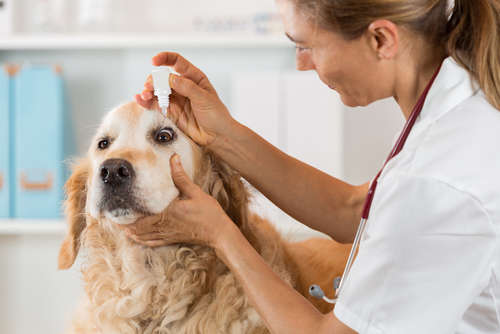
It is important to have your Golden Retriever’s eyes checked regularly by a veterinarian, especially if you notice any changes in their vision or behavior. Early detection and treatment of eye issues might help prevent further damage and maintain your dog’s quality of life.
Below are several recommendations that can help prevent or minimize eye issues in Golden Retrievers:
- Regular eye exams: Golden Retrievers should have regular eye exams with your vet or veterinary ophthalmologist to screen for eye issues such as Multifocal Retinal Dysplasia, Cataracts, PRA, Hereditary Cataract, Glaucoma, and Pigmentary Uveitis.
- Genetic testing: we can use genetic testing to identify dogs that are carriers of genetic mutations that cause eye issues such as PRA. Should you require additional details, please contact your veterinarian or ophthalmologist.
- Environmental modifications: modifying your Golden Retriever’s environment to reduce the risk of eye injuries, such as keeping hazardous materials and sharp objects out of reach, can help prevent eye issues.
Overall, following these recommendations may help minimize the risk of eye issues in Golden Retrievers and ensure their optimal eye health.
References
[1] (Essentials of Veterinary Ophthalmology; Kirk. N.Gelatt; Wiley Blackwell; Disease and surgery of the Caninae Anetrior Uvea; Pigmentary Uveitis in Golden Retrier; P 201-202)
[2] (Essentials of Veterinary Ophthalmology; Kirk. N.Gelatt; Wiley Blackwell; Disease and surgery of the Caninae Anetrior Uvea; Pigmentary Uveitis in Golden Retrier; P 201-202)
[3] (Essentials of Veterinary Ophthalmology; Kirk. N.Gelatt; Wiley Blackwell; Disease and surgery of the Caninae Anetrior Uvea; Pigmentary Uveitis in Golden Retrier; P 202)
[4] (Ocular Disorder; Presumed to be inherited in purebred dogs; 6th Edition; 2013; Genetics Committee of the American College of Veterinary Ophthalmologist; P 409)
[5] (Ocular Disorder; Presumed to be inherited in purebred dogs; 6th Edition; 2013; Genetics Committee of the American College of Veterinary Ophthalmologist; P 409)
[6] (Ocular Disorder ; Presumed to be inherited in purebred dogs; 6th Edition; 2013; Genetics Committee of the American College of Veterinary Ophthalmologist; P 409)
[7] (Ocular Disorder ; Presumed to be inherited in purebred dogs; 6th Edition; 2013; Genetics Committee of the American College of Veterinary Ophthalmologist; P 409)
[8] (Ocular Disorder; Presumed to be inherited in purebred dogs; 6th Edition; 2013; Genetics Committee of the American College of Veterinary Ophthalmologist; P 410)
[9] (Ocular Disorder; Presumed to be inherited in purebred dogs; 6th Edition; 2013; Genetics Committee of the American College of Veterinary Ophthalmologist; P 410)
[10] (Ocular Disorder; Presumed to be inherited in purebred dogs; 6th Edition; 2013; Genetics Committee of the American College of Veterinary Ophthalmologist; P 410)
[11] (Ocular Disorder; Presumed to be inherited in purebred dogs; 6th Edition; 2013; Genetics Committee of the American College of Veterinary Ophthalmologist; P 410)
Related posts:
Disclaimer: This website's content is not a substitute for veterinary care. Always consult with your veterinarian for healthcare decisions. Read More.



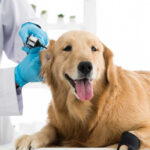
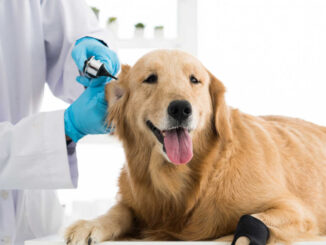
Be the first to comment